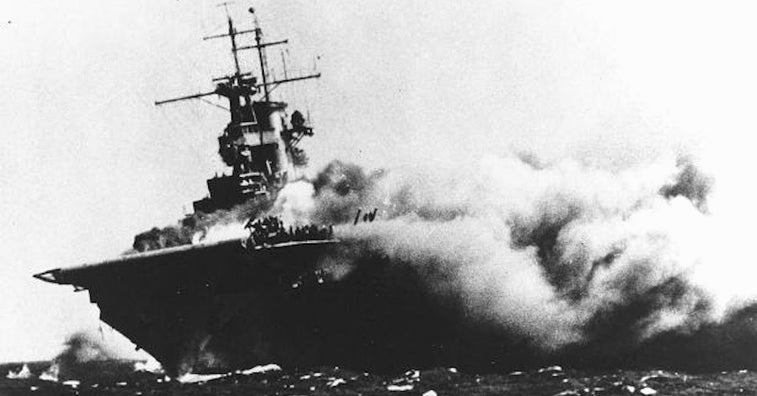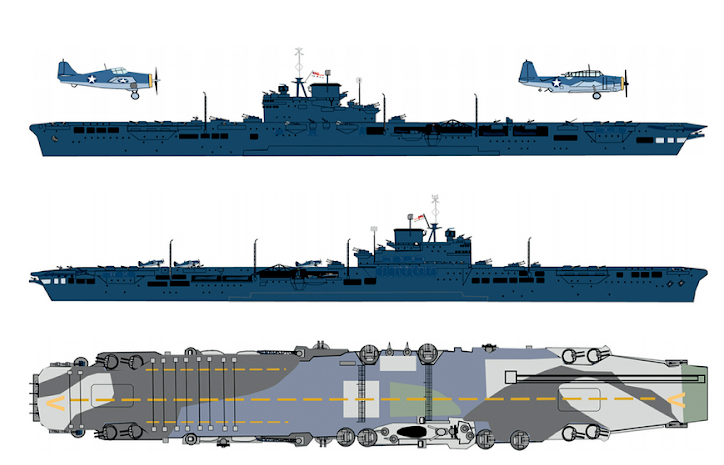Beginning on June 30, 1943, American soldiers, marines and sailors would endure three months of hard fighting to retake the New Georgia Islands from the Japanese in the Pacific. While the ground troops slugged their way through the thick jungles, the pilots above provided air support and tangled with Japanese fighters, keeping them at bay. And they needed a British aircraft carrier to help.
Beginning two days earlier and 300 miles offshore in the Coral Sea, aircraft carrier-based fighter planes flew combat air patrols from the USS Robin in order to intercept any Japanese carrier groups that might oppose the landings. After 28 days of constant air operations, launching 614 sorties and steaming 12,233 miles at an average of 18.1 knots, Robin returned to port to rest her crew and resupply—a record for a Royal Navy carrier.
After the Battle of the Santa Cruz Islands, the U.S. Navy was in a poor fighting state. USS Wasp had been sunk earlier at Guadalcanal and at Santa Cruz, USS Hornet was sunk and USS Enterprise was taken out of action to repair the damage she sustained during the battle. This left USS Saratoga as the only operational carrier to keep the Japanese and their four carriers at bay in the Pacific. In order to augment their strength, the U.S. Navy received a loan from Great Britain. In December 1942, at the highest possible level of negotiation, an agreement was made between Prime Minister Winston Churchill and President Franklin Roosevelt. To bolster their ally, the British Admiralty would loan the aircraft carrier HMS Victorious to the U.S. Navy to operate in the Pacific.

Victorious arrived at the Norfolk Naval Shipyard in January 1943 and was refitted for service with the U.S. Navy and operations in the Pacific theater. Now under American control, she was given the codename USS Robin. In dry dock, she was given new communications systems, surface and air radars, and an aircraft homing system to allow interoperability with the U.S. fleet. Her stern was also extended by 10 feet with an added gallery of twenty 20mm anti-aircraft guns to better counter the threat of Japanese air attack.
The Fleet Air Arm Fairey Albacore Torpedo-Bombers that she carried were replaced with TBM Avengers. The new planes were registered as American and bore U.S. Navy markings—however, they were crewed by Brits. Her Grumman Martlets (the British name for the F4F Wildcat) were also given U.S. Navy markings. The U.S. Navy sent aviators to train the British pilots on American procedures and tactics, and even sent American uniforms (though the crew is still pictured wearing their Royal Navy tropical uniform shorts).

After transiting the Panama Canal on February 14, Robin joined the U.S. Pacific Fleet and arrived at Pearl Harbor in March 1943. She underwent shakedown operations which revealed that her arrestor wires were not sufficient to stop the heavy Avengers. Heavier arrestor wires were fitted along with even more AA guns. At Pearl, she was also repainted in U.S. Navy blue grey to further disguise the British involvement with the U.S. Navy from the Axis Powers and prevent her from being mistaken as a Japanese ship. On May 8, she departed Pearl Harbor and sailed for the South Pacific where she joined up with USS Saratoga and formed Carrier Division 1 on May 17.

While conducting air operations in the Coral Sea in support of the New Georgia campaign, it was noticed that Robin handled her fighter wings well, but still had issues with the heavier Avengers. Commanding the carrier division, Rear Admiral DeWitt Ramsey transferred the Avengers of 832 Squadron FAA to the Saratoga and the F4F Wildcats of U.S. Carrier Air Group 3 to Robin. Neither carrier saw any engagement with the Japanese and the division returned to Nouméa on July 25. With the two newest Essex-class carriers, USS Essex and USS Lexington, arriving in Pearl Harbor and the Japanese withholding their carriers, Robin was returned to British control and recalled home.

She left her Avengers in Nouméa as replacements for the Saratoga and departed for Pearl Harbor on July 31. She sailed with the battleship USS Indiana and carried aboard a handful of U.S. pilots who had finished their tours and two Japanese POWs. Victorious made a brief stop in San Diego and sailed through the Panama Canal on August 26. She arrived in Norfolk on September 1 where her specialized U.S. equipment was removed. On September 26, she arrived at Greenock, Scotland and began refit for her return to Royal Navy service.

Victorious would finish the rest of the war with the Royal Navy. She participated in an attack on the German battleship Tirpitz, sister ship to the infamous Bismarck, with the British Home Fleet. In June 1944, she joined the Eastern Fleet and attacked Japanese installations in Sumatra. Victorious continued to conduct air operations in the Indian Ocean until February 1945 when she joined Task Force 113 at Sydney in preparation for the invasion of Okinawa.
TF113 joined the U.S. 5th Fleet at Ulithi in the Caroline Islands on March 25 as Task Force 57. Victorious conducted airstrikes against Japanese airfields on the Sakishima Islands and Formosa in support of the invasion until May 25. During these operations, she was hit by two kamikaze planes. However, unlike the wooden decks of her American counterparts, Victorious‘ armored flight deck resisted the worst of the impacts. She would go on to attack Japanese shipping and even seriously damaged the Japanese escort carrier Kaiyo before the end of the war.

After the war, Victorious was refitted and modernized with an angled flight deck. She continued her service in the Royal Navy until a fire broke out aboard in 1967. Although the damage was minor, the Defense Ministry was cutting its budget and the Royal Navy was facing a shortage of manpower, and Victorious would not be recommissioned. She was sold for scrap in 1969.
Though her time with the U.S. Navy saw no action, Victorious played an important role in bolstering the American air arm in the Pacific. Her sailors and airmen showed their American counterparts that they could do their job just as well and filled a critical shortage at a crucial point of the war.















































